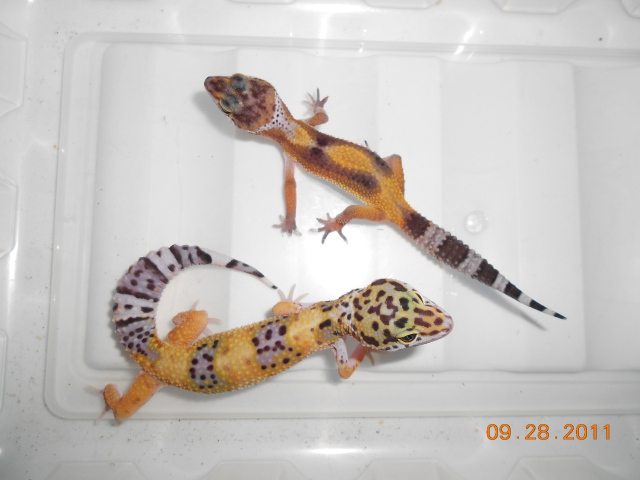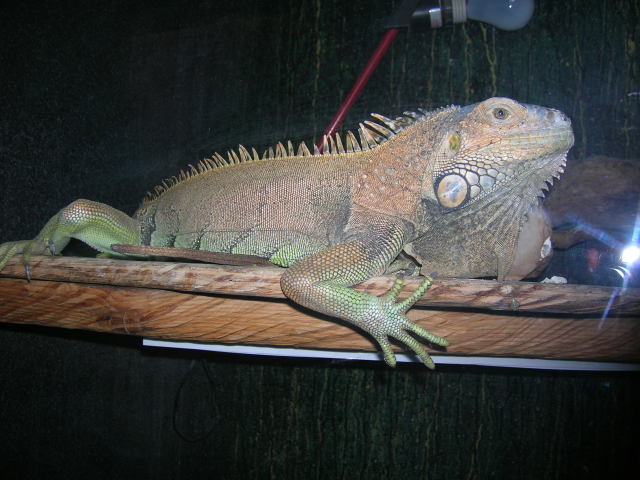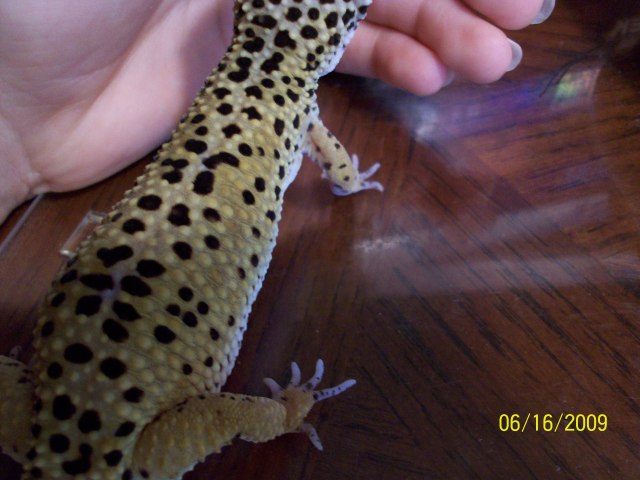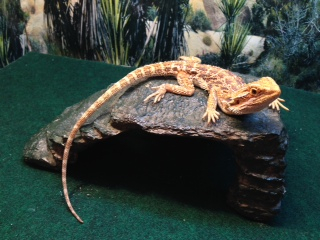QuestionQUESTION: Hi,
I recently acquired a m/f pair of young rankins dragons -- unfortunately they were obtained from someone who got them in a trade and isn't entirely sure how old they are or where they came from. I believe they're Caliente babies from last summer, but that's as good as I can guess.
My question is this -- they seem to be very ungainly little lizards, the smaller male especially. It's not uncommon for him to trip over his feet while he's walking around, and today he even mostly flipped over onto his face when he was lunging at a cricket, both back feet off the ground and his tail flipped over his head. The female is a bit better, but she too seems to have some difficulty with tripping over her feet walking now and then. The male also seems to sleep, a fair bit more than the female. He's certainly bright and active when crickets are introduced to the tank, or when I go to try to catch him, and he can run like the wind, without any obvious balance issues. I'm just wondering if this is just normal for adolescent Rankins (I don't recall ever seeing young beardies this ungainly) or if it's possibly a result of some neurological problem? I would have asked in a Rankin forum, but ... well, they're not terribly common lizards.
They're currently sharing a 29 gallon tank with a few hides and a stone basking spot of about 105 down to the mid 90s on the hot side and significantly cooler on the cool side of the tank. They're on a paper towel substrate, have a UVB bulb and are getting a varied diet of crickets, greens, violets and dandelions/greens, all dusted with vit D and herptivite multivitamins.
Taking them to a good herp vet would be a good way to get a solid answer, but so far I've tried a number of 'local' herp vets and not found one that has more than a solid basic understanding of reptiles. (One diagnosed unlaid eggs in an x-ray as tumors, another diagnosed a still unknown mass in a leo as constipation -- it's 6 months later and she's still got the mass, and is passing waste regularly) So, unfortunately, I don't really have any good vet options. Hoping you can help with my question, or point me to someone who might. :)
Thanks.
ANSWER: Hi Jennifer,
If the previous owner wasn't providing proper care, the tripping over their feet, etc can be due to a touch of Metabolic bone disease. Getting a good source of uvb on them and if possible, a few hours a day of real sunshine(mesh/open wire cage of course) should help with that. Along with the good diet you are providing should bring about results in a few weeks. I would add collard greens, mustard greens and turnip greens to their salad.
I doubt it would be a neurological problem as it is both of them acting the same way. Do their eyes look normal? There were some problems with certain uvb sources causing problems with eyes..but that generally shows up as swollen eyes...basically snow blindness.
I'm including a basic care sheet that I wrote..yes, its for bearded dragons but the Rankins care is pretty much the same. In the care sheet you can read more on good uvb sources.
There are also links to finding a vet so hopefully there is at least ONE on the list that will be a bit more knowing on reptiles.
I would go with a straight calcium powder, and limit the one with added Vitamin D to once a week, or just for dusting the insects. If there is not reason to suspect MBD, I would only supplement with calcium a few times a week... too much calcium/vitamins can cause what you are describing.
BASIC BEARDED DRAGON CARE:
HOUSING:
For an adult bearded Dragon, a 50 -55 gallon is the smallest recommended tank. For a baby, nothing less than a 30 gallon tank will work for a very short time, so its best to just start out with the adult sized tank....you can add rocks and branches for climbing, being sure to not stack rocks too high to prevent them toppling over. Branches need to be secure. They like to have a hide log or cave too!! All items brought from outside need to be cleaned well before placing them in the BD's tank. To clean them, there are a few methods: to wash in a bleach solution of 1/4 cup of bleach to 1 gallon of water. Let them soak for about an hour, rinse them in hot water several times and then let them dry in the sun until completely dry. If the items are small enough, they can be baked in an over at 200 degrees for about 2 hours, check often to be sure they are not starting to burn. The items can also be boiled(simmered) for 30 minutes or so and then allowed to dry completely before
placing in the tank. I also suggest washing any pet store items such as caves, rocks, branches, etc before placing in the tank as that if the store would happen to have mites they can also be on the items we purchase. Any of the above methods are acceptable for cleaning. CAUTION!!! On store bought branches...be VERY careful with the driftwood pieces that have the holes in them!!! Be sure the holes are small as that if the holes are large, the BD MAY be able to get his head in them but not able to get it back out!!! A secure screen top is necessary for bearded dragons as that also they do not require much height for climbing..they can and do climb!! NEVER USE HEAT ROCKS OR HEATED CAVES!!! They malfunction and cause severe burns and even death!!!!
SUBSTRATES:
Young bearded dragons MUST be kept on paper towels, newspaper or other non particulate(loose) substrate to prevent them from getting any loose substrate into their mouth and swallowing it which can and does cause intestinal blockages.Once the BD is over 10 inches, some people have had good luck using play sand mixed with 50% of peat moss. I prefer the safe substrate of the newspaper, or other non particulate substrate to prevent any problems and also for ease of cleaning.
LIGHTING:
BD's need UVB, which is the special lights that come in fluorescent tubes or special screw in bulbs(mercury vapor)that are designed to produce uvb and heat. The tubes do not produce heat. UVB is needed by the BD to be able to absorb the calcium in the foods they eat. Without the uvb, they will develop metabolic bone disease. With the tubes, they must say that they produce BOTH uvb and uva. The uvb needs to be 5% or higher. Repti Sun 5.0 and 10.0(not compact) are TWO of the best uvb tubes on the market. The repti glo 8.0's are a great uvb source also. Arcadia 5.0 (UK), which is the uvb tube available in the UK is a good uvb tube. These need to be positioned 6-8 inches(for the 5.0 and 8.0 and 8-10 inches for the 10.0) over the BD so that they get the uvb that is needed. Recommended length of the tube is 24 inches or more. They need to be replaced every 6-9 months as that they stop producing uvb long before they stop producing light. They need to have access to uvb and basking
temperatures for 10-12 hours daily. At night, no white lights!!!
There has been new studies that have proven that compact uvb lights, both the spiral/coil type and the ones that look like long "U's" laying on their side and a few other brands are causing what basically amounts to snow blindness in reptiles. The companies have corrected the problem but, there may still be some of the earlier manufactured bulbs out there so be sure to double check what you are using, or even if you are using proper uvb source. To read more on this, you can go to
http://www.uvguide.co.uk/index.htm
There are tubes and bulbs that say ''full spectrum'' but they do not produce any uvb.
On the mercury vapor , they also produce heat. They also produce the uvb and uva. The best on the market now are the MEGA RAY. www.reptileuv.com has more information on the Mega Ray lights. When using these, the distance is much greater than the uvb tubes and the directions must be followed that are listed for the light. When using the mercury vapor lights, you don't need to have one light for uvb and one for heat. The Mercury vapor lights provide both.
HEATING AND TEMPERATURES:
Bearded Dragons have specific temperature requirements. For heat when using the uvb producing fluorescent tubes, a regular household light bulb will work for DAYTIME heat. The wattage needed will vary to each situation such as tank size, room temperatures, air flow. Their basking area temperature must be between 95F and 105F degrees to allow proper digestion of food. Your basking area must be where the uvb light is as well as the heat source. Be sure that the BD cannot get too close to the heat source as that they WILL get burned! The ambient temperature range in the mid 80's . Cool daytime range of normal room temperature of low to mid 70's. Nighttime temperatures in the low to mid 60's is fine. NEVER USE HEAT ROCKS!!!!!!!!!!!!!!!!!!!!! A good digital thermometer is a must. I like using the duel ones with the probe...cost about 15$ at Wal Mart. The probe can be placed in the basking area at the BD's level to monitor this temperature and the main unit can be pl
aced in one of the ambient temperature areas. When reading them, the "out" reading is the probe area.
DIET:
Bearded Dragons eat and need both animal proteins and vegetable matter!!! As young dragons they eat a bit more of the insects. As they get older, as adults their diet is more of the vegetable matter. As young BDs, the diet is about 80% animal proteins and 20% vegetable matter. As they get older, the ratio changes. An adult will eat about 80%-90% vegetable matter and 10-20% animal proteins.
Animal protein sources are: Crickets, superworms, silkworms, roaches, hornworms, waxworms. Waxworms are considered candy to a BD so only feed on occasion in a small amount(2-3 worms). ALL insects must be properly gutloaded for at least 48 hours prior to feeding to the dragon. For crickets and superworms, this can be done with vegetables, plain cereals and commercial foods for the species. Silkworms and the other insects have their own diet needs. Its best to feed the crickets in a separate feeding tank such as a 10 or 20 gallon size tank or container with a well vented lid. This can make it easier for the dragon to catch the crickets and prevents any stray crickets in their "home" tank from deciding to nibble on the BD if he happens to not find them all. If you do feed in his home tank, be sure to place a 1/2 potato in the tank to help prevent the crickets from biting at the BD. ALL insects fed must be no larger than the space between their eyes to prevent choking. Be
sure to dust the insects daily(for dragons up to 14-15 inches) (2x wkly there after)with a good calcium source such as Rep Cal calcium powder with no added Phosphorus. Young BD's up to 4 months of age will eat more crickets than anything. At this age they will usually consume anywhere from 10 to 30+ correctly sized crickets three times a day. Be sure to remove any uneaten crickets that are not consumed in a 15-25 minute time frame. For this reason, its easier to use a separate feeding tank for the bearded dragon. A 10 gallon tank(with a screen top) works well. Its best to offer their "salad" of greens/veggies before offering their morning insect feeding when they are hungry to prevent any problems with them preferring NOT to eat their salad. Their salad consists of Collard greens, mustard greens, turnip greens, dandelion greens...... this is the BASE of the green part of their vegetable diet. To this, for variety you can add arugula, escarole, endive,small amounts of
bok choy or other Asian greens. For the vegetable part of the diet, green beans, butternut squash, acorn squash(other winter squashes are also acceptable) yams, sweet potato. For color, sweet peppers can also be added in a small amount. For baby BD's, using a food processor for the greens and veggies works well. As they get older, greens should never be larger than about an inch x an inch in size. Never feed lettuces as they have no nutritional value. The hard veggies should be either food processed or grated. Fruits can also be offered in small amounts. Good fruits are figs, papaya, melon, blueberries, strawberries, raspberries....and many other fruits... these need to be mashed or chopped. Watermelon is a good source of water for the dragon. Their salad can be dusted once or at the most, twice a month with a good vitamin supplement such as RepCal HerptiVit. This is by no means a complete list of foods the dragons can eat.You can also offer baby food chicken or
small bits of boiled chicken.
Be sure to provide a dish of FRESH drinking water at ALL times!!! Misting their salad will also help get much needed water into them. NEVER FEED any MICE or other mammals to your Dragon!!!
WATER:
As stated above, always provide a dish of drinking water and mist their salad. You can also bathe your dragon a few times a week. (many bathe them daily for "bathroom duties") Temperature of the water should be between 85 and 95 degrees. The depth should never be any deeper than to cover his back when laying FLAT!!! Never leave them unattended at bath time to prevent possible drowning. Many love to soak and swim for 15 minutes or more. Never bathe less than two hours before his basking lights go out. Doing so can cause him to become too chilled, risking the chance of a respiratory infection.
A vet check up is recommended and a fecal sample taken in to be tested for any internal parasites.... To find a qualified vet in your area you can go to
http://www.herpvetconnection.com
http://www.arav.org/ECOMARAV/timssnet/amm/tnt_mdsearch.cfm
http://www.anapsid.org/vets/
More in-depth care info can be found at:
http://www.bio..miami.edu/ktosney/file/BDcare.html
http://www.sundialreptile.com/care%20sheet--bearded%20dragon.htm
http://www.blackninjakitty.com/herps/dragons
Most bearded dragons will take long naps (generally,if they are over a yr) in the fall.. this is called Brumation. is a form of hibernation. You can read more about that at
http://www.exclusivedragons.com/Brumation.html be sure to read this link as it tells you what to look for in brumation vs illness.
http://www.bio.miami.edu/ktosney/file/BDbrumate.html
http://worldofbeardeddragons.blogspot.com/2006/11/bearded-dragon-brumation-bruma
---------- FOLLOW-UP ----------
QUESTION: Thank you for the quick and helpful response. I don't see any signs of MBD, spines, legs and toes are all nice and straight, so I don't think that's the problem. Their eyes are all normal too, no signs of bulging or any other obvious issues. In fact, both the dragons look, and seem to be behaving entirely normally except for the balance issues.
Right now they only get the vitamins and calcium/D3 on their crickets, which they're getting every other day or so, mostly due to their age. I was always under the impression that the reptiles couldn't absorb the calcium without the vitamin D? Should I cut back to dusting the crickets only once a week? The greens they've been getting have been primarily collard greens, with the dandelions and assorted other greens as a treat. If the issue is too much vitamins, is it reversable? What, exactly, causes the motor function problems?
I've had the Rankins for about 3 weeks now, and they're getting about 13 hours of UVB and heat lamp a day. It's still just way too cold here in New England to put them outside, though once it warms up a bit, I do have a mesh cage just for that. Since they've been getting (I hope) plenty of UV and a pretty solid diet, I'm hoping that I've either been over-vitamining them (and that's why it's affected the smaller dragon more)or they're just effectively Dragon teenagers who haven't quite figured out their bodies yet. I'm hoping the latter, but I think, at this point, I'll just have to wait and see.
AnswerHi Jennifer,
Its possible its their age but I've not heard/seen that before. A few other ideas...ear infection which can and would mess with balance. Another possibility can be too large of prey items being fed... I would try offering smaller crickets instead of the recommended size of no larger than the space between their eyes. With dragons,they are pigs and will try to eat anything, regardless of size. When they do this, it can cause a slight paralysis. In some cases, it can even be so bad that they actually drag their hind legs.When you are trying to catch them, their adrenaline may be high and they don't wobble/trip. I would stop the Vitamin D and see if that helps. Switch to a plain calcium once a week, twice at the most. Overdose of Vitamin D can and is a very serious problem which generally causes them to be lethargic and not eat..but..thats not to say you are seeing very early signs of it and since you sound like you are very attuned to your dragons, MAY have caught a big problem before it got to be a big problem.
One other silly thought... Is it possible that their claws a a bit too long and are getting stuck in the paper towels? I've seen this happen with leopard geckos and the reptile carpeting.
As to outdoors... you would be surprised how warm even a 60-65 degree day is in the sun, provided there is no breeze!!! They may not be able to be out for hours, but a bit of fresh air and sunshine may do them good. Also, you mention the 29 gallon, and with your comment, I'm guessing you are planning on a larger cage in the near future.

 Mediterranean Gecko
QuestionQUESTION: I have had a Mediterranean gecko for
Mediterranean Gecko
QuestionQUESTION: I have had a Mediterranean gecko for
 My leopard gecko babies
Question
The Leopard geckos bab
Two months ago,
My leopard gecko babies
Question
The Leopard geckos bab
Two months ago,
 Green Iguanas Longevity
Question
Ralph
I have had my green iguana for almost 15
Green Iguanas Longevity
Question
Ralph
I have had my green iguana for almost 15
 my leopard geckos health
QuestionQUESTION: Hello, I have a question about my leo
my leopard geckos health
QuestionQUESTION: Hello, I have a question about my leo
 Juvenile Beardie - sudden behavior change
QuestionQUESTION: I am new to Bearded Dragons but have
Juvenile Beardie - sudden behavior change
QuestionQUESTION: I am new to Bearded Dragons but have